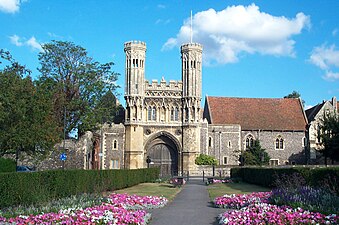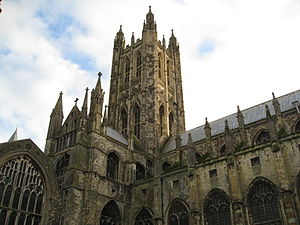| Canterbury | |
|---|---|
| City | |
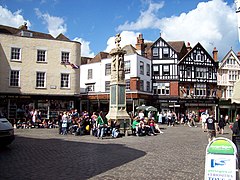 Butter Market square | |
 Arms of Canterbury | |
Location within Kent | |
| Population | 55,240 (2011)[1] |
| OS grid reference | TR145575 |
| • London | 54 miles (87 km)[2] |
| District | |
| Shire county | |
| Region | |
| Country | England |
| Sovereign state | United Kingdom |
| Post town | CANTERBURY |
| Postcode district | CT1, CT2, CT4 |
| Dialling code | 01227 |
| Police | Kent |
| Fire | Kent |
| Ambulance | South East Coast |
| UK Parliament | |
Canterbury (/ˈkæntərb(ə)ri/ , /-bɛri/)[3] is a city and UNESCO World Heritage Site, in the county of Kent, England; it was a county borough until 1974. It lies on the River Stour. The city has a mild oceanic climate.
Canterbury is a popular tourist destination, with the city's economy heavily reliant upon tourism, alongside higher education and retail. As of 2011, the city's population was over 55,000, including a substantial number of students and one of the highest student-to-permanent-resident ratios in Britain.
The city has been occupied since Paleolithic times and served as the capital of the Celtic Cantiaci and Jute Kingdom of Kent. Many historical structures fill the area, including a city wall founded in Roman times and rebuilt in the 14th century, the Westgate Towers museum, the ruins of St Augustine's Abbey, the Norman Canterbury Castle, and the oldest extant school in the world, the King's School. Modern additions include the Marlowe Theatre and Kent County Cricket Club's St Lawrence Ground. Canterbury Cathedral is known for its architecture, its music, and for being the seat of the Archbishop of Canterbury; it receives a million visitors per year.
History
[edit]Name
[edit]The Roman settlement of Durovernum Cantiacorum ("Kentish Durovernum") occupied the location of an earlier British town whose ancient British name has been reconstructed as *Durou̯ernon ("stronghold by the alder grove"),[4] although the name is sometimes supposed to have derived from various British names for the Stour.[5] Medieval variants of the Roman name include Dorobernia and Dorovernia.[5] In Sub-Roman Britain, it was known in Old Welsh as Cair Ceint ("stronghold of Kent").[6][7] Occupied by the Jutes, it became known in Old English as Cantwareburh ("stronghold of the Kentish men").[8]
Early history
[edit]The Canterbury area has been inhabited since prehistoric times. Lower Paleolithic axes, and Neolithic and Bronze Age pots have been found in the area.[9] Canterbury was first recorded as the main settlement of the Celtic tribe of the Cantiaci, which inhabited most of modern-day Kent. In the 1st century AD, the Romans captured the settlement and named it Durovernum Cantiacorum.[4] The Romans rebuilt the city, with new streets in a grid pattern, a theatre, a temple, a forum, and public baths.[10] Although they did not maintain a major military garrison, its position on Watling Street relative to the major Kentish ports of Rutupiae (Richborough), Dubrae (Dover), and Lemanae (Lymne) gave it considerable strategic importance.[11] In the late 3rd century, to defend against attack from barbarians, the Romans built an earth bank around the city and a wall with seven gates, which enclosed an area of 130 acres (53 ha).[10]
Despite being counted as one of the 28 cities of Sub-Roman Britain,[6][7] it seems that after the Romans left Britain in 410 Durovernum Cantiacorum was abandoned for around 100 years, except by a few farmers and gradually decayed.[12] Over the next 100 years, an Anglo-Saxon community formed within the city walls, as Jutish refugees arrived, possibly intermarrying with the locals.[13] The town's new importance led to its revival, and trades developed in pottery, textiles, and leather. By 630, gold coins were being struck at the Canterbury mint.[14] In 842 and 851, Canterbury suffered great loss of life during Danish raids.
11th–16th centuries
[edit]The siege of Canterbury saw a large Viking army besiege Canterbury in 1011, culminating in the city being pillaged. Remembering the destruction caused by the Danes, the inhabitants of Canterbury did not resist William the Conqueror's invasion in 1066.[8] William immediately ordered a wooden motte-and-bailey castle to be built by the Roman city wall. In the early 12th century, the castle was rebuilt with stone.[15] Canterbury Castle was captured by the French Prince Louis during his 1215 invasion of England, before the death of John caused his English supporters to desert his cause and support the young Henry III.[11]
Black Death reached Canterbury in 1348. At 10,000, Canterbury had the 10th largest population in England; by the early 16th century, the population had fallen to 3,000. In 1363, during the Hundred Years' War, a Commission of Inquiry found disrepair, stone-robbing and ditch-filling had led to the Roman wall becoming eroded. Between 1378 and 1402, the wall was virtually rebuilt, and new wall towers were added.[16] In 1381, during Wat Tyler's Peasants' Revolt, the castle and Archbishop's Palace were sacked, and Archbishop Sudbury was beheaded in London. In 1413, Henry IV became the only sovereign to be buried at the cathedral. In 1448 Canterbury was granted a City Charter, which gave it a mayor and a high sheriff; the city still has a Lord Mayor and Sheriff.[17]

In 1519 a public cage for talkative women and other wrongdoers was set up next to the town's pillory at the Bullstake, now the Buttermarket. In 1522 a stone cross with gilt lead stars was erected at the same place, and painted with bice and gilded by Florence the painter.[18]
History of Huguenot refugees
[edit]In the mid-16th century many Huguenots, experiencing persecution and conflict in the Low Countries, fled and resettled in Reformed regions such as England. Canterbury hosted the first congregation of so-called 'refugee strangers' in the country.[19] This first Huguenot church in Canterbury was founded around 1548, in part by Jan Utenhove who relocated from Strasbourg, alongside Valérand Poullain and François de la Rivière.[20] When Utenhove travelled to London in 1549, Francois de la Rivière remained to lead the congregation. With the accession of Mary I, the Huguenot residents of Canterbury were compelled to flee in 1553–4 alongside the English Marian exiles to Emden, Wesel, Zürich, Strasbourg, Frankfurt, and later Basel, Geneva, and Aarau.[21]
After the accession of Elizabeth I, a small number of Huguenots returned to London, including Jan Utenhove in 1559.[20] In 1561, a number of Huguenots in London were sent to Sandwich, a settlement which began to grow rapidly with new refugees arriving from Artois and Flanders. This settlement, in June 1575, almost entirely relocated to Canterbury, which had in the previous year gained a small Huguenot population. A number of refugees also arrived around this time from the temporary Huguenot settlements at Rye and Winchelsea.[22] In 1575, the Huguenot population of Canterbury were granted use of the church of St Alphedge but in the following year had begun to use the crypt of Canterbury Cathedral as their church.[23] The Church of the Crypt swiftly became the nucleus of the Huguenot community in Canterbury.
By the 17th century, French-speaking Huguenots comprised two-fifths of Canterbury's population. The Huguenots had a large influence on the economy of Canterbury, and introduced silk weaving into the city which had outstripped wool weaving by 1676.[24]
17th century–present
[edit]Canterbury remained an important city in the 17th century. Charles I and Henrietta Maria visited in 1625; musicians played whilst the couple entered the city under a velvet canopy supported by six men holding poles.[25] In 1647, during the English Civil War, riots broke out. The riots became known as the "Plum Pudding Riots".[26] The rioters' trial the following year led to a Kent revolt against Parliamentarian forces, contributing to the start of the second phase of the war. However, Canterbury surrendered peacefully to Parliamentarians at the Battle of Maidstone.[27]

By 1770, the castle had fallen into disrepair, and many parts of it were demolished during the late 18th century and early 19th century.[28] In 1787 all the gates in the city wall, except for Westgate—the city jail—were demolished as a result of a commission that found them impeding to new coach travel.[29] Canterbury Prison opened in 1808 just outside the city boundary.[30] By 1820 the silk weaving in the city had been supplanted by imported Indian muslins[24] and trade carried out was thereafter largely of hops and wheat.[11] The Canterbury & Whitstable Railway (The Crab and Winkle Way), the world's first passenger railway,[31] was opened in 1830;[32] bankrupt by 1844, it was purchased by the South Eastern Railway, which connected the city to its larger network in 1846.[33] The London, Chatham & Dover Railway arrived in 1860;[34] the competition and cost-cutting between the lines was resolved by merging them as the South Eastern & Chatham in 1899.[35] Between 1830 and 1900, the city's population grew from 15,000 to 24,000.[31]
During the First World War, barracks and voluntary hospitals were set up around the city. In 1917 a German bomber crash-landed near Broad Oak Road.[36] Mahatma Gandhi visited Canterbury in October 1931.[37][38] During the Second World War, 10,445 bombs dropped during 135 separate raids destroyed 731 homes and 296 other buildings in the city, including the missionary college and Simon Langton Girls' Grammar School.[39] 119 civilian people died through enemy action in the borough.[40] The most devastating raid was on 1 June 1942 during the Baedeker Blitz.[36] Before the end of the war, the architect Charles Holden drew up plans to redevelop the city centre, but locals were so opposed that the Citizens' Defence Association was formed; it swept to power in the 1945 municipal elections. Rebuilding of the city centre eventually began 10 years after the war.[41] A ring road was constructed in stages outside the city walls to alleviate growing traffic problems in the city centre, which was later pedestrianised. The biggest expansion of the city occurred in the 1960s, with the arrival of the University of Kent at Canterbury and Christ Church College.[41]
The 1980s saw visits from Queen Elizabeth II, and the beginning of the annual Canterbury Festival.[42] Between 1999 and 2005, the Whitefriars Shopping Centre underwent major redevelopment. In 2000, during the redevelopment, a major archaeological project was undertaken by the Canterbury Archaeological Trust, known as the Big Dig,[43] which was supported by Channel Four's Time Team.[44]
Geography
[edit]Climate
[edit]Canterbury experiences an oceanic climate (Köppen climate classification Cfb), similar to almost all of the United Kingdom. Canterbury enjoys mild temperatures all year round, being between 1.8 °C (35.2 °F) and 22.8 °C (73 °F). There is relatively little rainfall throughout the year.
| Climate data for Canterbury | |||||||||||||
|---|---|---|---|---|---|---|---|---|---|---|---|---|---|
| Month | Jan | Feb | Mar | Apr | May | Jun | Jul | Aug | Sep | Oct | Nov | Dec | Year |
| Mean daily maximum °C (°F) | 7.6 (45.7) |
7.8 (46.0) |
10.7 (51.3) |
13.4 (56.1) |
16.8 (62.2) |
20.0 (68.0) |
22.8 (73.0) |
22.8 (73.0) |
19.4 (66.9) |
15.3 (59.5) |
10.9 (51.6) |
8.1 (46.6) |
14.7 (58.5) |
| Daily mean °C (°F) | 4.3 (39.7) |
4.3 (39.7) |
6.4 (43.5) |
8.2 (46.8) |
11.6 (52.9) |
14.3 (57.7) |
16.8 (62.2) |
16.9 (62.4) |
14.3 (57.7) |
10.9 (51.6) |
7.1 (44.8) |
5.3 (41.5) |
10.0 (50.0) |
| Mean daily minimum °C (°F) | 2.1 (35.8) |
1.8 (35.2) |
3.5 (38.3) |
4.9 (40.8) |
7.7 (45.9) |
10.5 (50.9) |
12.9 (55.2) |
12.8 (55.0) |
10.8 (51.4) |
8.0 (46.4) |
4.8 (40.6) |
2.5 (36.5) |
6.9 (44.4) |
| Average precipitation mm (inches) | 62.2 (2.45) |
42.2 (1.66) |
41.3 (1.63) |
42.9 (1.69) |
50.0 (1.97) |
39.0 (1.54) |
40.0 (1.57) |
51.2 (2.02) |
61.6 (2.43) |
83.2 (3.28) |
68.8 (2.71) |
63.4 (2.50) |
645.8 (25.43) |
| Mean monthly sunshine hours | 60.9 | 80.7 | 116.5 | 174.2 | 206.0 | 206.4 | 221.8 | 214.9 | 155.2 | 125.0 | 73.3 | 48.6 | 1,683.3 |
| Source 1: [45] | |||||||||||||
| Source 2: [46] | |||||||||||||
Demography
[edit]| 2001 UK Census | Canterbury city | Canterbury district | England |
|---|---|---|---|
| Total population | 43,432 | 135,278 | 49,138,831 |
| Foreign born | 11.6% | 5.1% | 9.2% |
| White | 95% | 97% | 91% |
| Asian | 1.8% | 1.6% | 4.6% |
| Black | 0.7% | 0.5% | 2.3% |
| Christian | 68% | 73% | 72% |
| Muslim | 1.1% | 0.6% | 3.1% |
| Hindu | 0.8% | 0.4% | 1.1% |
| No religion | 20% | 17% | 15% |
| Unemployed | 3.0% | 2.7% | 3.3% |
At the 2001 UK census,[47][48][49][50][51][52] the total population of the city itself was 43,432, and 135,278 within the Canterbury district. In 2011, the total district population was counted as 151,200, with an 11.7% increase from 2001,[53] and the population of the city had grown to over 55,000.[54] By 2015, Canterbury's student population, including the University of Kent and Canterbury Christ Church University, and the smaller University for the Creative Arts, was almost 40,000.[55]
| Population growth in Canterbury since 1901 | ||||||||||||||||||
|---|---|---|---|---|---|---|---|---|---|---|---|---|---|---|---|---|---|---|
| Year | 1901 | 1911 | 1921 | 1931 | 1939 | 1951 | 1961 | 1971 | 2001 | |||||||||
| Population | 24,899 | 24,626 | 23,737 | 24,446 | 26,999 | 27,795 | 30,415 | 33,155 | 43,432 | |||||||||
| Source: A Vision of Britain through Time | ||||||||||||||||||
Physical
[edit]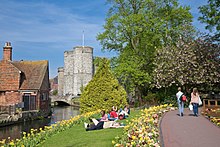
Canterbury is in east Kent, about 55 miles (89 km) east-southeast of London. The coastal towns of Herne Bay and Whitstable are 6 miles (10 km) to the north, and Faversham is 8 miles (13 km) to the northwest.[56] The city is on the River Stour or Great Stour.[57] The river is navigable on the tidal section to Fordwich, although above this point canoes and other small craft can be used.[58] The geology of the area consists mainly of brickearth overlying chalk. Tertiary sands overlain by London clay form St. Thomas's Hill and St. Stephen's Hill about a mile northwest of the city centre.[59]
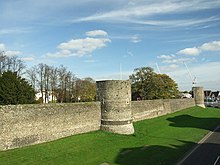
Canterbury is a medieval city, with Canterbury Cathedral inside the ring of the city walls, forming the historic centre. Of the defensive structures, a section of the medieval walls remains to the south, near Canterbury Castle, while to the northwest, the Westgate survives as the Westgate Towers museum. Immediately outside the Westgate is the River Stour which crosses the city from southwest to northeast.[60] A road runs straight across the city from the Westgate, forming the High Street (including St George's Street) and part of the North Downs Way.[61] St Augustine's Abbey lies just outside the city walls.[62]
Political
[edit]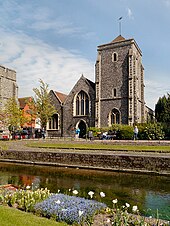
The city became a county borough under the Local Government Act 1888.[63] In 1974, under the Local Government Act 1972, the city came under the control of Kent County Council. Canterbury, along with Whitstable and Herne Bay, is now in the City of Canterbury local government district.[64] The city's urban area consists of the six electoral wards of Barton, Blean Forest, Northgate, St Stephens, Westgate, and Wincheap. These wards have eleven of the fifty seats on the Canterbury City Council, which governs the city.[65]
The former Holy Cross Church building was officially re-opened by the Prince of Wales as the new Canterbury Guildhall and meeting place of the City Council on 9 November 1978.[66]
The Member of Parliament for the Canterbury constituency, which includes Whitstable, is Rosie Duffield of the Labour Party.[67]
Economic
[edit]
Canterbury district retained approximately 4,761 businesses, up to 60,000 full and part-time employees and was worth £1.3 billion in 2001.[68] This made the district the second largest economy in Kent.[68] Today, the three primary sectors are tourism, higher education and retail.[69]
In 2015, the value of tourism to the city of Canterbury was over £450 million; 7.2 million people visited that year, making it one of the most-visited cities in England. A full 9,378 jobs were supported by tourism, an increase of 6% over the previous year.[70][71] The two universities provided an even greater benefit. In 2014/2015, the University of Kent and Canterbury Christ Church University were worth £909m to city's economy and accounted for 16% of all jobs.[72]

Unemployment in the city dropped 0.6 percentage points to 1.7% from 2001 to 2007.[73] The registered unemployment rate as of September 2011 stood at 5.7%. By May 2018, the rate had dropped to 1.8%; in fact, Kent in general had a moderate unemployment rate of 2%. This data considers only people claiming either Jobseekers Allowance or Universal Credit principally for the reason of being unemployed. It does not include those without access to such benefits.[74] At the time, the national rate was 4.2%.[75]
A report in 2023 by the Poverty Working Group of the Canterbury Sustainable Development Goals Forum evidenced increasing poverty in the city using, for example, life expectancy figures and the number of meals provided by the city food banks, as well as interviews with organisations and individuals attempting to help those in danger of and in poverty.[76][77] This supports earlier findings on poverty in the city.[78][79]
Culture
[edit]Landmarks
[edit]
The 17th century, double jettied, half-timbered Crooked House bookshop operated by the Catching Lives homelessness charity at the end of Palace Street, opposite Kings School is frequently photographed for its quirky, slanted appearance.[80] Canterbury Roman Museum houses an in situ mosaic pavement dating from around 300 AD.[81] Other surviving Roman structures in the city include Queningate, a blocked gate in the city wall, and the Dane John Mound, once part of a Roman cemetery.[82] The Dane John Gardens were built beside the mound in the 18th century, and a memorial placed on the mound's summit.[83]
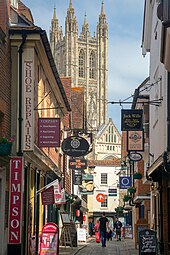
Westgate Towers is a museum narrating its earlier use as a jail. The medieval church of St Alphege is as of 2022[update] used by the King's School. The Old Synagogue, now the King's School Music Room, is one of only two Egyptian Revival synagogues still standing. The city centre contains many timber-framed 16th and 17th century houses but others were destroyed, particularly in the Second World War Baedeker Blitz. Survivors include the Huguenot "Old Weaver's House".[84] St Martin's Mill is the only surviving mill out of the six known to have stood in Canterbury. It was built in 1817 and worked until 1890 but is now a residence.[85]
Theatres
[edit]The Marlowe Theatre is named after Christopher Marlowe, who was born in the city.[86] It was formerly located in St Margaret's Street but moved to the present location in 1984.[87] It was completely rebuilt in 2011 with a main 1,200-seat auditorium and secondary performance space. Its modern structure is a landmark across the city.[88] The University of Kent's Gulbenkian Theatre serves the city, and incorporates a cinema and café.[89] Other theatrical performances take place at Canterbury Cathedral and St Augustine's Abbey.[90] The oldest surviving theatre building in Canterbury is The Shakespeare bar which had been a playhouse in the Tudor period.[91] Theatre companies in Canterbury include The Canterbury Players.[92]

Music
[edit]In common with many English towns and cities in the Middle Ages, Canterbury employed a band of waits. There are records of payments to the waits from 1402, though they probably existed earlier. The waits were disbanded by the city authorities in 1641 for 'misdemeanors' but reinstated in 1660 when they played for the visit of King Charles II on his return from exile.[93] Civic waits were ultimately abolished nationally by the Municipal Corporations Act of 1835 but a modern, early music group called The Canterbury Waits has revived the name.[94]
Canterbury's Catch Club was a musical and social club which met in the city between 1779 and 1865. Its male club members met weekly in the winter and employed an orchestra to assist in performances for the first half of their evening. After an interval, the members sang catches and glees from the club's extensive music library which is now deposited at Canterbury Cathedral's archives.[95]
In the late 1960s and early 1970s the Canterbury Scene emerged comprising progressive rock, avant-garde and jazz musicians established within the city. Members included Soft Machine, Caravan, Matching Mole, Egg, Hatfield and the North, National Health, Gilgamesh, Soft Heap, Khan and In Cahoots.[96] Ian Dury, front man of 1970s rock band Ian Dury and the Blockheads, taught Fine Art at Canterbury College of Art and early incarnations of his band Kilburn and the High Roads performed in the city.[97] Canterbury Choral Society give regular concerts in Canterbury Cathedral, typically large-scale classical choral works.[98] The Canterbury Orchestra, founded in 1953, perform major works from the symphonic repertoire.[99] Other local musical groups include the Canterbury Singers, founded in 1953; Cantemus; and the City of Canterbury Chamber Choir.[100]
The Canterbury Festival takes place over two weeks in October including musical events ranging from opera and symphony concerts to world music, jazz and folk.[101] From 2006 to 2015 the July Lounge On The Farm music festival presented rock, indie and dance artists near Canterbury.[102]
Sport
[edit]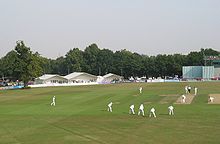
Cricket
Canterbury is the home of Kent County Cricket Club, with the St Lawrence Ground hosting many of the team's matches. It has also been used for several One Day Internationals, including an England match during the 1999 Cricket World Cup.[103]
The St Lawrence Ground is notable for being one of only two grounds used regularly for first-class cricket that have had a tree within the boundary, the other being the City Oval in Pietermaritzburg.
American Football
There have been multiple American football teams based in Canterbury since the game was popularised in the UK. Currently, the city is the home of the East Kent Mavericks, 2023 BAFA National Leagues Southern Football Conference 2 Champions, as well as teams from both universities.
Football
Canterbury City F.C. reformed in 2007 as a community interest company and currently compete in the Southern Counties East Football League. The previous incarnation of the club folded in 2001.[104]
Rugby
Canterbury RFC were founded in 1926 and became the first East Kent club to achieve National League status and currently play in the fourth tier, National League 2 South.[105]
Tour de France
The cycling Tour de France passed through the city in 1994, and again in 2007 when it hosted the finish for Stage 1.[106]
Hockey
Canterbury Hockey Club is one of the largest in the country; it enters teams in both the Men's and Women's England Hockey Leagues.[107] Former Olympic gold medal winner Sean Kerly has been a member.[108]
Public Facilities
Public sporting facilities are provided at Kingsmead Leisure Centre, including a 33-metre (108 ft) swimming pool and sports hall for football, basketball, and badminton.[109]
Education
[edit]Universities
[edit]
Canterbury hosts some 31,000 students and has the highest student to permanent resident ratio in the UK.[110] They attend three universities, and other higher education institutions.[111] The University of Kent's main campus extends to 600 acres (243 ha) and is situated on Saint Stephen's Hill, a mile north of Canterbury city centre. As of 2014[update], it enrolled around 20,000 students.[112] Canterbury Christ Church University was founded as a teacher training college in 1962 by the Church of England; in 2005 it became a university. As of 2007[update], it had around 15,000 students.[113] The Franciscan International Study Centre is close to the University of Kent campus.[114]
Schools
[edit]
King's School is the oldest secondary school in the United Kingdom. St. Augustine established it shortly after his 597 arrival in Canterbury though documented history of it only began after dissolution of the monasteries in the 16th century, when it took the present name in honour of Henry VIII.[115]
The city's secondary grammar schools are Barton Court Grammar School, Simon Langton Grammar School for Boys and Simon Langton Girls' Grammar School, all of which in 2008 had over 93% of their pupils gain five or more GCSEs at grades A* to C including English and maths.[116]
Transport
[edit]Rail
[edit]
The pioneering Canterbury & Whitstable Railway, known locally as the Crab and Winkle line, had a terminus at North Lane station. It ran from 3 May 1830 to 1953 and was the first regular passenger steam railway in the world.[117] Canterbury South railway station was sited on the Elham Valley Railway. The station opened in 1889 and closed, along with the rest of the railway, in 1947.[118]
Canterbury West railway station is operated by Southeastern.[119] Canterbury East railway station, (Canterbury's other station) is also operated by Southeastern.[120] There is no direct interchange between Canterbury West and Canterbury East stations because the two railways into the city were built by rival companies. Canterbury Parkway railway station has been proposed as an additional station outside of the city, with links to both lines.[121]
Bus
[edit]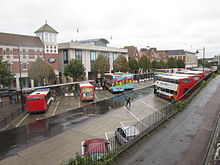
Stagecoach run local bus routes in Canterbury, as well as long-distance services. Its bio fuel 'Unibus' service operates between the city centre and University of Kent.[122] Canterbury has two operational park and ride sites at Wincheap[123] and New Dover Road,[124] both intended for visitors arriving from the south by road.
Cycling
[edit]National Cycle Routes 1 runs through Canterbury from Dover and Sandwich to Whitstable.[125] National Cycle Route 18 runs from Canterbury to Ashford.[126]
Local media
[edit]Newspapers
[edit]Canterbury's first newspaper was the Kentish Post, founded in 1717.[127] It merged with newly founded Kentish Gazette in 1768[128] which is still being published, claiming to be the country's second oldest surviving newspaper.[129] It is currently produced as a paid-for newspaper by KM Group in Whitstable with a 25,000 circulation across East Kent.[130]
Three free weekly newspapers provide local news. The Daily Mail and General Trust's Canterbury Times has a circulation of 55,000.[131][132] Similar circulation Canterbury Extra is owned by KM Group.[133] yourcanterbury is published by KOS Media, which also prints Kent on Sunday.[134]
Radio
[edit]Local radio stations are BBC Radio Kent on 104.2FM, Heart South on 102.8FM and KMFM Canterbury on 106FM. KMFM Canterbury was formerly KMFM106, and from foundation in 1997 until KM Group took control CTFM, a reference to Canterbury's CT postcode.[135] KMFM's studio moved from the city to Ashford in 2008.[136] Canterbury Hospital Radio serves Kent and Canterbury Hospital,[137] and SBSLive's coverage is limited to the Simon Langton Boys School grounds.[138]
Television
[edit]Local news and television programmes are provided by BBC South East and ITV Meridian from the Dover TV transmitter.
Notable people
[edit]Composer Orlando Gibbons (1583–1625) died in Canterbury[139] and is commemorated by a marble bust and memorial tablet in the cathedral.[140] The grave of author Joseph Conrad, in Canterbury Cemetery, is a Grade II listed building.[141]
Other people connected with Canterbury include:
- Aphra Behn, restoration playwright and novelist[142]
- Orlando Bloom, actor[143]
- Thomas Sidney Cooper, painter[144]
- Benjamin Chandler, 18th-century surgeon[145]
- David Gower, cricketer[146]
- William Harvey, physician[147]
- Sir Freddie Laker, airline entrepreneur[148]
- Christopher Marlowe, poet and playwright[149]
- W. Somerset Maugham, writer[147]
- Pink Pantheress, singer[150]
- Joseph McManners, singer and actor[151]
- Fiona Phillips, TV presenter[152]
- Trevor Pinnock, harpsichordist and conductor[153]
- Michael Powell, film director[147]
- Edmund Reid, detective[154]
- Mary Tourtel, creator of Rupert Bear,[155]
- Mimi Webb, singer[156]
International relations
[edit]Canterbury is twinned with the following cities:
- Reims, France[157]
- Esztergom, Hungary[158]
- Saint-Omer, France, since 1995[159]
- Wimereux, France, since 1995[159]
- Certaldo, Italy, since 1997[159]
- Vladimir, Russia, since 1997[159]
- Mölndal, Sweden, since 1997[159]
- Tournai, Belgium, since 1999[159]
- Bloomington, Illinois, United States[159]
Religion
[edit]In 597, Pope Gregory the Great sent Augustine to convert its King Æthelberht to Christianity. After the conversion, Canterbury, being a Roman town, was chosen by Augustine as the centre for his episcopal see in Kent, and an abbey and cathedral were built. Augustine thus became the first Archbishop of Canterbury.[160] In 672, the Synod of Hertford gave the see of Canterbury authority over the entire English Church.[8] In 978, Archbishop Dunstan refounded the abbey built by Augustine, and named it St Augustine's Abbey.[161] In 1504 the cathedral's main tower, the Bell Harry Tower, was completed, ending 400 years of building. Cardinal Wolsey visited in June 1518 and was given a present of fruit, nuts, and marchpane. During the Dissolution of the Monasteries, the city's priory, nunnery and three friaries were closed. St Augustine's Abbey, the 14th richest in England at the time, was surrendered to the Crown, and its church and cloister were levelled. The rest of the abbey was dismantled over the next 15 years, although part of the site was converted to a palace.[162]
After the murder of the Archbishop Thomas Becket at the cathedral in 1170, Canterbury became one of the most notable towns in Europe, as pilgrims from all parts of Christendom came to visit his shrine.[163] This pilgrimage provided the framework for Geoffrey Chaucer's 14th-century collection of stories, The Canterbury Tales.[164] Thomas Becket's shrine in the cathedral was demolished in 1538 by King Henry VIII, all the gold, silver, and jewels were removed to the Tower of London, and Becket's images, name and feasts were obliterated throughout the kingdom, ending the pilgrimages. In 1620, Robert Cushman negotiated the lease of the Mayflower at 59 Palace Street for the purpose of transporting the Pilgrims to America. In 1647, during the English Civil War, riots broke out when Canterbury's puritan mayor banned church services on Christmas Day. In 1848, St Augustine's Abbey was refurbished for use as a missionary college for the Church of England's representatives in the British colonies.[11] The extensive restoration of the cathedral that was underway in mid 2018 was part of a 2016–2021 schedule that includes replacement of the nave roof, improved landscaping and accessibility, new visitor facilities and a general external restoration.[165] The so-called Canterbury Journey project was expected to cost nearly £25 million.[166]
Canterbury Cathedral is Mother Church of the Anglican Communion and seat of the Archbishop of Canterbury. Founded in 597 AD by Augustine, it forms a World Heritage Site, along with Saxon St. Martin's Church and the ruins of St Augustine's Abbey. The cathedral receives a million visitors annually and is one of the most visited places in the country. Services are held three or more times a day.[167][168]
St Thomas of Canterbury Church is the only Roman Catholic church in the city and contains relics of Thomas Becket.[169]
-
St. Augustine's Abbey gateway
-
St. Augustine's Abbey
-
Canterbury Cathedral
-
Christchurch Gate, Canterbury Cathedral
In popular culture
[edit]Chaucer’s text became the inspiration for the 1944 British film, A Canterbury Tale by Michael Powell and Emeric Pressburger, starring Eric Portman, Sheila Sim, Dennis Price and Sgt. John Sweet, filmed in the city in the aftermath of the destruction caused by German bombing during World War Two.
In more recent popular culture, Canterbury appeared in Russell Hoban’s 1980 post apocalyptic novel Riddley Walker, renamed "Cambry".[170]
References
[edit]- ^ "2011 Census – Built-up areas". ONS. Archived from the original on 21 September 2013. Retrieved 6 May 2014.
- ^ "Grid Reference Finder". gridreferencefinder.com. Archived from the original on 26 September 2019. Retrieved 23 January 2021.
- ^ Roach, Peter; Hartman, James; Setter, Jane; Jones, Daniel, eds. (2006). Cambridge English Pronouncing Dictionary (17th ed.). Cambridge: Cambridge University Press. ISBN 978-0-521-68086-8.
- ^ a b Lyle 2002, p. 29.
- ^ a b Hasted, Edward (1800). The History and Topographical Survey of the County of Kent. Vol. XI. Canterbury: W. Bristow. pp. 135–139. Archived from the original on 17 February 2015. Retrieved 13 February 2015.
- ^ a b Nennius (attrib.). Theodor Mommsen (ed.). Historia Brittonum, VI. Composed after AD 830. (in Latin) Hosted at Latin Wikisource.
- ^ a b Ford, David Nash. "[www.britannia.com/history/ebk/articles/nenniuscities.html The 28 Cities of Britain]" at Britannia. 2000.
- ^ a b c "Canterbury Timeline". Channel 4. Archived from the original on 15 January 2009. Retrieved 28 May 2008.
- ^ Lyle 2002, p. 16.
- ^ a b Lyle 2002, pp. 43–44.
- ^ a b c d Godfrey-Faussett 1878, p. 29.
- ^ Lyle 2002, p. 42.
- ^ Lyle 2002, pp. 42, 47.
- ^ Lyle 2002, pp. 48–50.
- ^ Lyle 2002, pp. 64, 66.
- ^ Lyle 2002, pp. 86–87.
- ^ Lyle 2002, p. 91.
- ^ HMC 9th Report: Canterbury (London, 1883), p. 150.
- ^ Cross, Francis William (1898). History of the Walloon & Huguenot Church at Canterbury. p. 3.
- ^ a b Cross, Francis William (1898). History of the Walloon & Huguenot Church at Canterbury. pp. 4-6.
- ^ Garrett, Christina Hallowell (10 June 2010). The Marian Exiles: A Study in the Origins of Elizabethan Puritanism (1 ed.). Cambridge University Press. p. 47. doi:10.1017/cbo9780511707957. ISBN 978-1-108-01126-6.
- ^ Cross, Francis William (1898). History of the Walloon & Huguenot Church at Canterbury. pp. 13-23
- ^ "The church in the 16th century: The Walloon period | Église Protestante Française de Cantorbéry". www.frenchchurchcanterbury.org.uk. Archived from the original on 19 January 2024. Retrieved 19 January 2024.
- ^ a b Lyle 2002, p. 107.
- ^ HMC 9th Report: Canterbury (London, 1883), p. 163.
- ^ "Cancelled Christmas and the Plum Pudding Riots". Vaguely Interesting. Archived from the original on 7 December 2022. Retrieved 7 December 2022.
- ^ Lyle 2002, p. 109.
- ^ Tatton-Brown, Tim. "Canterbury Castle". Canterbury Archaeological Trust. Archived from the original on 18 January 2010. Retrieved 30 May 2008.
- ^ Lyle 2002, p. 110.
- ^ Canterbury, UK: HM Prison Service, archived from the original on 16 February 2008, retrieved 24 September 2008
- ^ a b Butler 2002, p. 11.
- ^ Ratcliffe, R.L. (1980), Canterbury & Whitstable Railway 1830–1980, Locomotive Club of Great Britain, ISBN 978-0-905270-11-1
- ^ White, H.P. (1961), A Regional History of the Railways of Southern England, vol. II, London: Phoenix House, pp. 16–8
- ^ Godfrey-Faussett 1878, p. 28.
- ^ Awdry, Christopher (1990), Encyclopaedia of British Railway Companies, Sparkford: Patrick Stephens, p. 199, ISBN 978-1-8526-0049-5
- ^ a b Butler 2002, p. 13.
- ^ "Wikilivres". Archived from the original on 6 July 2017. Retrieved 8 December 2018.
((cite web)): CS1 maint: unfit URL (link). wikilivres.ca. Retrieved on 25 August 2011. - ^ Special Collections – Library Services – University of Kent Archived 12 October 2008 at the Wayback Machine. Library.kent.ac.uk. Retrieved on 25 August 2011.
- ^ Lyle 2002, p. 127.
- ^ "Cemetery Details". Archived from the original on 23 June 2019. Retrieved 23 June 2019.
- ^ a b Butler 2002, p. 14.
- ^ Butler 2002, p. 15.
- ^ "Canterbury Archaeological Trust: Previous articles: Big Dig". Archived from the original on 15 May 2009.
- ^ Butler 2002, p. 16.
- ^ "Canterbury climate". Archived from the original on 15 April 2019. Retrieved 29 March 2017.
- ^ "Weather statistics for Canterbury, England (United Kingdom)". Archived from the original on 12 January 2019. Retrieved 29 March 2017.
- ^ "Barton (Ward)". Statistics.gov.uk. Archived from the original on 10 January 2009. Retrieved 27 May 2008.
- ^ "Harbledown (Ward)". Statistics.gov.uk. Archived from the original on 11 January 2009. Retrieved 27 May 2008.
- ^ "Northgate (Ward)". Statistics.gov.uk. Archived from the original on 11 January 2009. Retrieved 27 May 2008.
- ^ "St Stephens (Ward)". Statistics.gov.uk. Archived from the original on 11 January 2009. Retrieved 27 May 2008.
- ^ "Westgate (Ward)". Statistics.gov.uk. Archived from the original on 11 January 2009. Retrieved 27 May 2008.
- ^ "Wincheap (Ward)". Statistics.gov.uk. Archived from the original on 11 January 2009. Retrieved 27 May 2008.
- ^ "Census 2011 result shows increase in population of the South East". webarchive.nationalarchives.gov.uk. 16 July 2012. Archived from the original on 5 January 2016.
- ^ "Canterbury Population 2018 (Demographics, Maps, Graphs)". worldpopulationreview.com. Archived from the original on 12 July 2018. Retrieved 11 July 2018.
- ^ Pragnell, Chris (10 October 2015). "Canterbury's student population now 40,000 – double 10 years ago". Kent Online. Archived from the original on 16 June 2023. Retrieved 16 June 2023.
- ^ "Where is Canterbury". Get The Data. Archived from the original on 10 June 2023. Retrieved 10 June 2023.
- ^ "Background information on the River Stour". kentishstour.org.uk. Archived from the original on 27 July 2020. Retrieved 14 April 2020.
- ^ Kent & Canterbury Tourist Attraction | Canterbury Historic River Tours Archived 26 January 2010 at the Wayback Machine. Canterburyrivertours.co.uk. Retrieved on 25 August 2011.
- ^ Lyle 2002, p. 15.
- ^ "Visit Canterbury". Canterbury City Council. Archived from the original on 16 June 2023. Retrieved 16 June 2023.
- ^ "Work on transformation of St George's Street in Canterbury high street to start on Monday". Kent Online. 12 January 2023. Archived from the original on 16 June 2023. Retrieved 16 June 2023.
- ^ "St Augustine's Abbey". English Heritage. Archived from the original on 16 June 2023. Retrieved 16 June 2023.
- ^ "Kent County Council". Science Museum Group. Archived from the original on 16 June 2023. Retrieved 16 June 2023.
- ^ McDermott, Jonathan (31 October 2022). "Canterbury City Council". Town Planning Expert. Archived from the original on 16 June 2023. Retrieved 16 June 2023.
- ^ "Statistical Bulletin June 2021 Kent Analytics, Kent County Council www.kent.gov.uk/research Ward boundary changes in Kent:2019" (PDF). Kent County Council. June 2021. Archived from the original (PDF) on 5 December 2016. Retrieved 16 June 2023.
- ^ "Remember Prince is Freeman of City". Kentish Gazette. 14 February 2013. Archived from the original on 25 June 2021. Retrieved 21 February 2021.
- ^ "Rosie Duffield". UK Parliament. Archived from the original on 10 June 2023. Retrieved 10 June 2023.
- ^ a b Proposals to the Casino Advisory Panel Archived 28 May 2008 at the Wayback Machine Culture.gov.uk. Retrieved on 25 May 2008
- ^ "The Economy – The Canterbury Society". www.canterburysociety.org.uk. Archived from the original on 11 July 2018. Retrieved 11 July 2018.
- ^ "Canterbury's £450 million tourism boost". Canterbury City Council.[permanent dead link]
- ^ "Canterbury | The Southeast Guide". Rough Guides. 1 June 1942. Archived from the original on 22 January 2013. Retrieved 26 March 2013.
- ^ "Universities' £900m impact on the Canterbury economy – University of Kent". The University of Kent. 18 February 2016. Archived from the original on 12 July 2018. Retrieved 11 July 2018.
- ^ Economic Profile 2007 – Canterbury Kent County Council. Retrieved on 25 May 2008 Archived 28 May 2008 at the Wayback Machine
- ^ "Unemployment in Kent" (PDF). Archived (PDF) from the original on 11 July 2018. Retrieved 11 July 2018.
- ^ "Unemployment figures drop". Kent Online. 12 June 2018. Archived from the original on 12 July 2018. Retrieved 11 July 2018.
- ^ Poverty in Canterbury Today by Jan Pahl and Martin Vye with Tim Carlyle, Dawn Ryder and Jane Webb Sustainable Development Goals Forum 2023 https://www.canterburysociety.org.uk/wp-content/uploads/2023/04/JanPahl_A4_ReportOnPovertyInCanterbury-v3.pdf Archived 7 April 2023 at the Wayback Machine
- ^ Howard, Charlotte (14 December 2018). "Canterbury has highest rates of child poverty in Kent". The Canterbury Hub. Archived from the original on 7 April 2023. Retrieved 7 April 2023.
- ^ "Poverty-stricken area 'one of worst in country'". Kent Online. 17 June 2019. Archived from the original on 7 April 2023. Retrieved 7 April 2023.
- ^ Boyden, Katie (16 May 2019). "These are the areas in Kent worst hit by child poverty". KentLive. Archived from the original on 7 April 2023. Retrieved 7 April 2023.
- ^ "Catching Lives Bookshop". Catching Lives. 27 July 2021. Archived from the original on 24 September 2022. Retrieved 3 December 2022.
- ^ Scheduled monument listing held at Kent County Council
- ^ Lyle 2002, p. 142.
- ^ Tellem 2002, p. 37
- ^ Lyle 2002, pp. 142–147.
- ^ Coles Finch, William (1933). Watermills and Windmills. London: C W Daniel Company. pp. 177–178.
- ^ Tellem 2002, p. 38.
- ^ "Our History". Marlowe Theatre. Archived from the original on 20 September 2015. Retrieved 25 August 2015.
- ^ Mara, Felix (17 December 2010). "Theatre design: Marlowe Theatre, Canterbury by Keith Williams Architects and..." Architects Journal. Archived from the original on 28 July 2022. Retrieved 28 July 2022.
- ^ The Gulbenkian Theatre, UK: University of Kent, 25 May 2008, archived from the original on 21 May 2008, retrieved 25 May 2008
- ^ The Marlowe Theatre, Canterbury, Kent, UK, archived from the original on 14 May 2008, retrieved 25 May 2008
- ^ "The Shakespeare". shakespearecanterbury.co.uk. Archived from the original on 23 January 2021. Retrieved 23 January 2021.
- ^ The Canterbury Players: Canterbury's leading amateur dramatics group, archived from the original on 1 April 2009, retrieved 18 June 2009
- ^ James M. Gibson, 'The Canterbury Waits', in: Records of Early English Drama. Kent: Diocese of Canterbury. University of Toronto Press and The British Library, 2002.
- ^ The Canterbury Waits Archived 7 February 2009 at the Wayback Machine. Themusickcabinet.co.uk (30 July 2011). Retrieved on 25 August 2011.
- ^ Canterbury Cathedral Library Archived 14 September 2010 at the Wayback Machine. Canterbury-cathedral.org. Retrieved on 25 August 2011.
- ^ "Canterbury Scene". AllMusic. Archived from the original on 11 January 2023. Retrieved 29 May 2008.
- ^ "Biography". Ian Dury. Archived from the original on 16 August 2019. Retrieved 26 August 2019.
- ^ Canterbury Choral Society Archived 15 September 2010 at the Wayback Machine. Mdesignsolutions.co.uk (18 June 2011). Retrieved on 25 August 2011.
- ^ The Canterbury Orchestra Archived 27 May 2011 at the Wayback Machine. The Canterbury Orchestra (8 January 2010). Retrieved on 25 August 2011.
- ^ "City of Canterbury Chamber Choir". Archived from the original on 12 December 2009. Retrieved 21 December 2009.
- ^ Welcome to the Canterbury Festival, Kent's International Arts Festival | Home Archived 11 October 2008 at the Wayback Machine. Canterburyfestival.co.uk (13 August 2011). Retrieved on 25 August 2011.
- ^ Warren, Gerry. "Lounge on the Farm festival shelved for a year". Archived from the original on 9 July 2021. Retrieved 30 June 2021.
- ^ "St Lawrence Ground". Cricinfo. Archived from the original on 15 August 2009. Retrieved 26 August 2009.
- ^ "Canterbury City F.C". Canterbury City F.C. Archived from the original on 9 August 2018. Retrieved 29 December 2018.
- ^ "A Brief History of Canterbury RFC". Canterbury RFC. Archived from the original on 22 April 2008. Retrieved 29 May 2008.
- ^ "Tour de France Canterbury". Canterbury City Council. Archived from the original on 26 April 2008. Retrieved 29 May 2008.
- ^ About Canterbury Hockey Club Archived 14 May 2008 at the Wayback Machine. Canterbury Hockey Club. Retrieved on 25 May 2008
- ^ Canterbury. Tourist Guide & Directory. Retrieved on 25 May 2008
- ^ "Kingsmead Leisure Centre – Our Facilities". Active Life. Archived from the original on 14 May 2008. Retrieved 29 May 2008.
- ^ Kentish Gazette 14 May 2015
- ^ Higher and Further Education in the Canterbury District: An Impact Review [1] Archived 23 January 2021 at the Wayback Machine
- ^ "University profile". University of Kent. Archived from the original on 2 June 2008. Retrieved 28 May 2008.
- ^ "History". Canterbury Christ Church University. Archived from the original on 12 October 2007. Retrieved 28 May 2008.
- ^ "Welcome - Franciscans". Franciscans.ac.uk. Archived from the original on 6 July 2018. Retrieved 25 May 2008.
- ^ "A Brief History of the King's School, Canterbury". The King's School. Archived from the original on 28 September 2011. Retrieved 28 May 2008.
- ^ "Secondary schools in Kent: GCSE-level". BBC News. 15 January 2000. Archived from the original on 23 January 2021. Retrieved 31 July 2009.
- ^ Graham Martin, From Vision to Reality: the Making of the University of Kent at Canterbury (University of Kent at Canterbury, 1990) pages 225–231 ISBN 0-904938-03-4
- ^ Hart, Brian (2015). The Elham Valley Railway. Bath: Wild Swan Books. ISBN 9780953877126.
- ^ "Canterbury West Railway Station". The ABC Railway Guide. Archived from the original on 10 June 2023. Retrieved 10 June 2023.
- ^ "Canterbury East Railway Station". The ABC Railway Guide. Archived from the original on 10 June 2023. Retrieved 10 June 2023.
- ^ "MP Rosie Duffield in talks over proposals for new Canterbury Parkway railway station". Kent Online. 31 August 2018. Archived from the original on 9 November 2020. Retrieved 10 March 2020.
- ^ Canterbury Times (September 26, 2013). Retrieved May 9, 2016.[permanent dead link]
- ^ "Wincheap Park & Ride – Car Park". Archived from the original on 5 May 2023. Retrieved 5 May 2023.
- ^ "New Dover Road Park & Ride – Car Park". Archived from the original on 5 May 2023. Retrieved 5 May 2023.
- ^ "Route 1". Sustrans. Archived from the original on 8 June 2023. Retrieved 10 June 2023.
- ^ "Route 18". Sustrans. Archived from the original on 10 June 2023. Retrieved 10 June 2023.
- ^ RM Wiles, Freshest advices: early provincial newspapers in England, Ohio State University Press, 1965, p. 397.
- ^ KM Group – Over 150 years of history Archived 3 August 2009 at the Wayback Machine. Kentonline.co.uk. Retrieved on 25 August 2011.
- ^ About the team – Kentish Gazette Archived 7 June 2009 at the Wayback Machine. Kentonline.co.uk. Retrieved on 25 August 2011.
- ^ "Kentish Gazette". The Newspaper Society and AdWeb Ltd. Archived from the original on 9 February 2006. Retrieved 28 May 2008.
- ^ "Canterbury Times". mediaUK. Archived from the original on 16 May 2008. Retrieved 28 May 2008.
- ^ "Canterbury Adscene". The Newspaper Society and AdWeb Ltd. Archived from the original on 9 February 2006. Retrieved 28 May 2008.
- ^ "Canterbury KM Extra". The Newspaper Society and AdWeb Ltd. Archived from the original on 9 February 2006. Retrieved 28 May 2008.
- ^ "yourcanterbury website". KOS Media. Archived from the original on 22 August 2009. Retrieved 6 September 2009.
- ^ KMFM 106 Archived 14 July 2007 at the Wayback Machine KMFM Canterbury Website. Retrieved on 30 May 2008.
- ^ "Co-location request for KMFM". Archived from the original on 29 February 2012.
- ^ Hospital radio Archived 9 May 2010 at the Wayback Machine. Canterbury Hospital Radio. Retrieved on 30 May 2008.
- ^ Simon Langton Grammar School for Boys[permanent dead link]. Retrieved on 25 May 2008.
- ^ Huray, Peter Le; Harper, John (2001). Gibbons, Orlando. doi:10.1093/gmo/9781561592630.article.11092. ISBN 978-1-56159-263-0. Archived from the original on 5 October 2021. Retrieved 5 October 2021 – via Grove Music Online.
- ^ "Gibbons – Canterbury History". Archived from the original on 31 January 2020. Retrieved 5 October 2021.
- ^ "Canterbury City Cemetery: Joseph Conrad Memorial". britishlistedbuildings.co.uk. Archived from the original on 28 January 2015. Retrieved 24 January 2015.
- ^ Topping, Alexandra (24 June 2021). "Aphra Behn fans campaign for statue of playwright in Canterbury home". The Guardian. Archived from the original on 10 June 2023. Retrieved 10 June 2023.
- ^ "Orlando Bloom". BFI. Archived from the original on 8 January 2022. Retrieved 8 January 2022.
- ^ "cooper-ts – Canterbury History". www.canterbury-archaeology.org.uk. Archived from the original on 6 November 2018. Retrieved 13 March 2019.
- ^ "Benjamin Chandler". Inspiring Physicians. Royal College of Physicians. Retrieved 18 April 2024.
- ^ "David Gower lord of the manor". BBC News. Archived from the original on 29 May 2008. Retrieved 29 May 2008.
- ^ a b c "Some Famous OKS". The King's School. Archived from the original on 28 September 2011. Retrieved 28 May 2008.
- ^ "Sir Freddie Laker – British entrepreneur who pioneered low-cost air travel". The Guardian. Archived from the original on 5 January 2017. Retrieved 29 May 2008.
- ^ "Christopher Marlowe – Some biographical facts". Prestel. Archived from the original on 23 June 2008. Retrieved 29 May 2008.
- ^ Hynes, Hayley (13 March 2024). "What Is Pinkpantheress' Ethnicity? How the Songstress Takes Pride In Her Kenyan Roots". Yahoo! News. Retrieved 18 April 2024.
- ^ "Joseph McManners Biography". JoeMcManners. Archived from the original on 8 December 2008. Retrieved 25 May 2008.
- ^ "Fiona Phillips". Lycos. Archived from the original on 2 May 2008. Retrieved 29 May 2008.
- ^ Aryeh Oron. "Trevor Pinnock (Conductor, Harpsichord)". Archived from the original on 29 July 2003.. Bach Cantatas.com. Retrieved on 16 December 2019
- ^ Nesling, Jodie (5 June 2018). "Campaign to give policeman Edmund Reid who hunted Jack the Ripper a proper headstone". Archived from the original on 28 October 2021. Retrieved 19 December 2022.
- ^ "MARY TOURTEL (1879–1940)". Chris Beetles. Archived from the original on 7 May 2008. Retrieved 29 May 2008.
- ^ Hoffman, Grace (21 April 2022). "Pop star Mimi Webb recalls life in Canterbury after 'living a dream' touring US". KentLive. Archived from the original on 19 December 2022. Retrieved 19 December 2022.
- ^ Canterbury City Council – Twinning contacts. Retrieved on 14 October 2009. Canterbury.gov.uk (1 March 2011). Retrieved on 25 August 2011.
- ^ "Testvérvárosok". esztergom.hu (in Hungarian). Esztergom. Archived from the original on 11 April 2021. Retrieved 28 March 2021.
- ^ a b c d e f g Canterbury City Council – International Links. Retrieved on 17 January 2011 Archived 4 January 2011 at the Wayback Machine
- ^ Lyle 2002, pp. 47–48.
- ^ Lyle 2002, p. 53.
- ^ Lyle 2002, pp. 97–100.
- ^ "Descriptive Gazetteer entry for Canterbury". Vision of Britain. Archived from the original on 22 October 2012. Retrieved 28 May 2008.
- ^ "The Canterbury Tales by Geoffrey Chaucer". British Library. Archived from the original on 3 February 2016. Retrieved 6 February 2016.
- ^ "Physical Works". Archived from the original on 22 June 2018. Retrieved 11 July 2018.
- ^ "Canterbury Cathedral £25 million restoration leaves it like a building site". 23 June 2018. Archived from the original on 12 July 2018. Retrieved 11 July 2018.
- ^ "Canterbury Cathedral". Canterbury Cathedral. Archived from the original on 15 June 2008. Retrieved 30 May 2008.
- ^ "Crumbling cathedral 'needs £50m'". BBC News. 3 October 2006. Archived from the original on 15 June 2008. Retrieved 30 May 2008.
- ^ Canterbury – St Thomas of Canterbury Archived 4 February 2016 at the Wayback Machine from English Heritage, retrieved 29 January 2016
- ^ "Places – Riddley Walker Annotations". Errorbar. Archived from the original on 29 July 2021. Retrieved 21 August 2022.
Sources
[edit]- Godfrey-Faussett, Thomas Godfrey (1878), , in Baynes, T. S. (ed.), Encyclopædia Britannica, vol. 5 (9th ed.), New York: Charles Scribner's Sons, pp. 28–30
- Butler, Derek (2002), A Century of Canterbury, Sutton Publishing, ISBN 978-0-7509-3243-1
- Lyle, Marjorie (2002), Canterbury: 2000 Years of History, Tempus, ISBN 978-0-7524-1948-0
- Tellem, Geraint (2002), Canterbury and Kent, Jarrold Publishing, ISBN 978-0-7117-2079-4
External links
[edit]- Canterbury City Council
- Canterbury Buildings website Archived 11 December 2023 at the Wayback Machine – Archaeological and heritage site of Canterbury's buildings.
| International | |
|---|---|
| National | |
| Geographic | |

